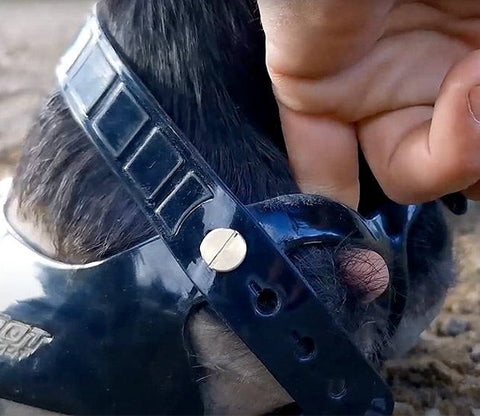Why We Fit Boots Snug Even When It's Early in the Trim Cycle
One of the most common things I hear when choosing a boot size with a customer is "These new boots (or fitting boots) seem snug and my horse is only 2 weeks into the trim cycle. I'm worried they won't fit at 6 weeks".

When fitting there are several factors we check. Ideally the gap at the front of the boot will be about a pinky's width, there will be a little bit of room on the sides of the boot to allow for growth widthwise. And most importantly, you should be able to get a finger between the horse and the horizontal heel strap (this test is done with gaiters OFF, but please use your gaiters for riding, especially with new boots). The heel strap should also be at the proper height, hooking over the top of the heel bulbs to function like an anchor. All aspects of fit may not be perfect, but the most important factor of fit is the heel strap.
Ideally boots should be fit early in the trim cycle, no more than 2 weeks after a fresh trim. So the question is, if you can just get a finger in the heel strap then, what happens by the end of the trim cycle? First, new boots are at their smallest and are a bit stiffer than broken in boots. As the boots are used throughout the trim cycle, they will soften a bit and the fit will relax and stretch as they are worn.
How much will they stretch? I measured my very worn out boots and the sole of the boot was about 5mm longer and wider than a new boot, and the opening around the top of the boot was also about 5mm longer and wider. 5mm is a whole boot size! And the entire shape of the boot opening is just a bit rounder. It has molded to my horse's shape. The boots also feel softer than a new boot.

How can you ensure your new boots will soften, stretch and break in properly? The best way is to put them on your horse and ride! Aim for at least once a week during the first trim cycle, starting with a couple of rides no more than 4 miles. Monitor the boots during your test rides and check the heels afterwards. If all goes well, you're ready to get out again and ride that pony!

By using them consistently (at least once a week) through the first trim cycle, the breaking in and stretching will keep pace with hoof growth. If this protocol is followed, the boot should still fit nicely at the end of the trim cycle, and pass the finger test, while not being too loose after a fresh trim.

If you don't use the boots consistently through the first trim cycle, for example, you only use them week 1 and week 5, they are very likely going to be too tight at week 5. They haven't been going through the stretching process that happens with use.
If you don't have time to tack up and ride during the first cycle, you can just put the boots on and take your horse for a little walk, do some lunging and groundwork, or just turn them out for a few hours in them. Don't turn them out 24x7 right off the bat, the boots need to break in before full time use. Keep it to 2 or 3 hours max. If you purchased the boots for purposes of turnout you can gradually increase the hours.

I often get requests to fit boots in the middle of a trim cycle. This is not ideal for the same reasons. In order for a new boot to not be too tight mid- to late-trim, we'd likely have to go up a size. But as soon as you got a trim that boot would be too loose.
That said, life is not always perfect, and I do sometimes fit boots later in a trim cycle, for example if someone has an event coming up that they desperately need boots for. These cases usually require going with the smaller size (the size we would have put them in if fit in the first 2 weeks) but stretching the heel strap. (More on that in this blog post: https://timberlinetack.com/blogs/news/heat-fitting-your-scoot-boots-for-optimal-fit ) Late fittings are a last resort, however. It makes sizing trickier and increases the odds for issues since a heat stretch only stretches the heel strap and is not quite the same as breaking in a boot.
Even if boots are broken in properly, SOME horses may require light rasping between trims in order to wear the boots through a 6 week cycle.

I'm a big fan of owners doing rasping between trims (or at least being able to) anyway! Not only for boot fitting reasons but also for the good of the hoof. But that's another blog post for another day!
Hope that explains it - happy to answer any further questions! I can be reached at:
- eMail: karen@timberlinetack.com
- Facebook Messenger: https://m.me/TimberlineTackAndScootBoots
